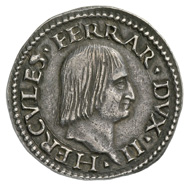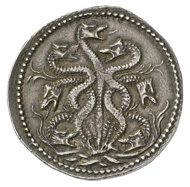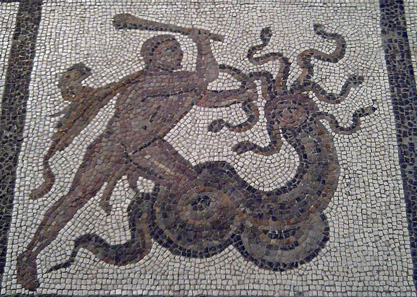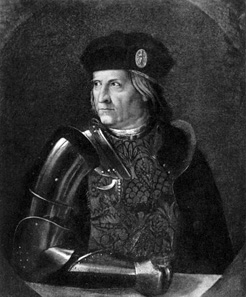courtesy of the MoneyMuseum, Zurich
translated by Teresa Teklic
Why was the human head the motif on coins for centuries, no, for millennia? And why did that change in the last 200 years? Ursula Kampmann is looking for answers to these questions in her book “Menschengesichter” (“Human faces”), from which the texts in this series are taken.
Ferrara, Ercole I d’Este (1471-1505). Testone. Head of Ercole to the right. Rv. Seven-headed Hydra. © MoneyMuseum, Zurich.
For more than 300 years, Ferrara had been ruled by the House of Este, an aristocratic family whose roots could be traced back all the way to Charles the Great. Not quite as longstanding, but nevertheless several generations old, was the family’s tradition of promoting the arts and sciences. In 1392, Alberto I founded one of Europe’s oldest universities. He raised his son Nicolò III entirely in the spirit of traditional humanism. He surrounded himself with scholars, who shared their thoughts and ideas with him. So, in the late 1430s, Pietro Andrea de’ Bassi dedicated his work “The labours of Hercules” to Nicolò, who read it attentively.
Since the early Renaissance, the mythological figure of Hercules had been known as the embodiment of the ideal prince, who was strong but wise, a just ruler, a true philosopher and, beyond that, was the defender of the suppressed and the protector of widows and orphans. In this idealised image, he had gained his place in the canon of antiquity’s greatest heroes. Renaissance artists often portrayed him in contemporary dress, in a knight’s armour at a tournament.
Bassi now staged the Labours of Hercules in a contemporary setting and painted a detailed picture of the future hero’s education: a combination of humanist studies and physical exercise. He laid out a scene depicting Hercules at a crossroads, having to decide between the personifications of idleness and virtue. Hercules favours virtue, who becomes his loyal companion in times of war and peace. Bassi further interpreted the Labours of Hercules allegorically.
Hercules and the Lernaean Hydra. Mosaic detail, Spain. Source: Luis García / http://creativecommons.org/licenses/by-sa/2.0/deed.en
Hercules’s victory over the Hydra, as it is depicted on our coin, symbolises the triumph of wisdom over physical strength. Only when Hercules used his wits next to the physical strength that was necessary to cut off the monster’s heads and gave the order to cauterise the wounds, so that the Hydra would be unable to grow new heads, was he able to defeat his enemy.
Ercole I d’Este. Source: Wikicommons.
Nicolò was a huge admirer of Hercules, this exemplary prince, and tellingly named his son Ercole, Hercules. Ercole I d’Este was very much aware of the high expectations that his name raised: in 1475, he had Bassi’s work printed and his coins decorated with Hercules’s heroic deeds. He especially favoured the one that he could identify with the most: the killing of the Hydra, the victory of wisdom over brute force.
Next episode’s story resembles a fairy tale: we will witness how Francesco Sforza started out as a common mercenary and became the Duke of Milan.
If you want to see Ursula Kampmann’s favourite cartoon connected with the Hydra, click here.
You can find all episodes in the series here.
A German edition of the book “Menschengesichter” is available in print and as ebook on the site of the Conzett Verlag.







